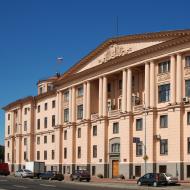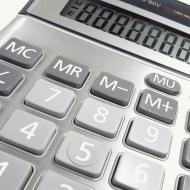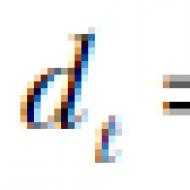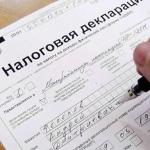
The country's trade and payments balances are summarized. Trade and payments balances of the country. Basic elements of currency systems. Currency convertibility
A country's balance of payments is an accounting of the country's trade and financial transactions with other countries of the world for a certain period (year, quarter, month)
The balance of payments consists of two sections - receipts and payments. If receipts exceed payments, then the balance of payments is active (there is a positive balance), otherwise it is passive.
The balance of payments reflects the true picture characterizing the real effect or loss of foreign trade. The information contained in the balance of payments makes it possible to assess the volume and quality of a country's participation in the international exchange of goods, services and capital. Therefore, problems of the balance of payments, surplus or deficit, are of great public interest and affect political decision-making.
The basis of the balance of payments is the trade balance. The trade (foreign trade) balance characterizes the export and import of goods. The trade balance is positive if a country exports more goods and services than it imports from abroad. In this case, the trade balance has a surplus. If imports are greater than exports, then the trade balance is negative or in deficit. Therefore, changes in the current account balance are associated with changes in domestic output and employment.
The balance of trade is built on the basis of customs statistics, which takes into account the volume of goods actually crossing the border, while the balance of payments takes into account payments and receipts during foreign trade turnover, which may not coincide in time with the movement of goods.
The balance of payments, in addition to trade, includes foreign loans, interest on them, investment income, transfer payments and exchange of financial assets. This balance is called the capital account balance. Transactions under each of these items represent payments flowing either into or out of the country. The purchase of assets (value inflow) requires the expenditure of foreign currency (just like regular imports of goods), so it takes a negative sign in the capital account. Sales of assets (outflow of value) are similar to exports in the trade balance, so they appear with a plus sign in the capital account.
Each international transaction is reported twice in the balance of payments: as a credit and as a debit. This is explained by the fact that every transaction has two sides: if a country buys something from foreign countries, then it pays for it. Consequently, a country's balance of payments reflects both the flow of goods and the flow of payments for them.
Credit is an outflow of values from a country, which must be followed by payments to that country.
A debit is an influx of value into a country for which residents of that country must pay.
The general rule for accounting for international transactions is as follows: a transaction in which a country receives foreign currency is called a credit and is entered in the balance of payments with a plus sign, and a transaction in which a country spends foreign currency is called a debit and is entered in the balance of payments with a minus sign. Exports are usually paid for in foreign currency, hence it is a loan. Imports must be paid for in foreign currency, hence it is a debit.
The state of the balance of payments and trade is influenced by both external and internal factors. These include: the impact of cyclical factors, price dynamics, in particular the dynamics of current world prices for raw materials, exchange rate changes, growth or decline in domestic demand for consumer and investment goods, foreign economic policies of states aimed at increasing or restraining exports or imports.
Russia’s balance of payments quite often remained passive: the foreign trade surplus, which depended primarily on the situation on the world energy market, was opposed by much larger payments and obligations for international services, repayment of foreign currency debt, and the import of cash dollar bills, to which was added legal and especially the illegal outflow of capital abroad. The difference had to be covered by new external borrowings, which is why Russia became one of the world's largest debtors.
"Trade and payment balances of the country" and others
The balance of payments is one of the main tools for macroeconomic analysis and forecasting.
The balance of payments is the ratio of the actual payments made by a given country abroad and the receipts it receives from abroad over a certain period of time.
Balance of payments data reflects how trade with other countries developed during the reporting period, which directly affects the level of production, employment and consumption, how much income was received from non-residents and how much was paid to them. These data allow us to track the form in which foreign investment was attracted, whether the country's external debt was repaid on time or whether there were arrears and restructuring, and how the central bank eliminated payment imbalances by increasing or decreasing the size of its foreign currency reserves.
The division of the balance of payments into specific accounts, or components, should be based on a number of principles, among which the following should be particularly emphasized:
- · each item of the balance of payments must have its own characteristics, that is, a factor or a combination of factors influencing the volume of one item must differ from the factors affecting other items;
- · the presence of one or another item in the balance of payments should have significance for a group of countries, expressed both in the dynamics of change of this item and in its absolute value. In other words, if any indicator of the balance of payments system is subject to strong fluctuations over a certain period of time for a group of countries, or it occupies a large share in the balance of payments of a group of countries, then it should be highlighted as a separate item;
- · collecting information for accounting by item should not present any particular difficulties for balance of payments compilers (however, this principle is secondary to the first two);
- · the structure of the balance of payments should be such that balance of payments indicators are combined with other statistical systems, for example, the system of national accounts; at the same time, the number of items should not be excessively numerous, and the items themselves should be subject to consolidation into higher-level components (so that countries that have not reached a high level of processing statistical information are able to present the balance of payments with less detail).
Standard balance components can be divided into two main groups
I “Balance of payments for current transactions”:
a) payments and receipts from foreign trade operations, or trade balance;
b) balance of services (international transportation, freight, insurance, etc.) and non-commercial transactions (settlements for technical assistance patents), income and payments on investments;
II “Balance of capital flows (short-term and long-term operations) and loans.”
The balance of capital and credit movements is followed by an item called “Errors and Omissions,” which shows unaccounted movements of short-term capital. Changes in foreign exchange reserves reflect the international foreign exchange operations of central banks associated with equalizing the balance of payments and maintaining the exchange rate of the national currency. Foreign trade indicators traditionally occupy an important place in the balance of payments. The ratio of the value of exports and imports of goods forms the trade balance. Since a significant part of foreign trade is carried out on credit, there are differences between the figures for trade, payments and receipts actually made during the relevant period.
The economic significance of an asset or trade deficit in relation to a particular country depends on its position in the world economy, the nature of its relations with partners and general economic policy.
For countries that lag behind the leaders in terms of economic development, a trade surplus is necessary as a source of foreign currency to pay international obligations under other balance of payments items. For a number of industrialized countries, trade surpluses are used to create a second economy abroad. A passive trade balance is considered undesirable and is usually assessed as a sign of weakness in the country's foreign economic position. This is right for developing countries facing a shortage of foreign exchange earnings. This may have a different meaning for the industrial development of countries.
Of course, if exports decline due to falling demand for a given country's goods in other countries, this is a bad sign. But if a negative balance arises, for example, in the case of an increase in imports of investment goods and growth as a result of domestic production, then in this case the negative balance cannot serve as a basis for negative assessments of the state of the economy. In other words, an asset or trade deficit can only be assessed on the basis of an analysis of the circumstances leading to it.
In a planned economy, the document summarizing the foreign economic relations of the USSR was the consolidated currency plan. Reports on the implementation of this plan actually served as the country's balance of payments. The currency plan was a closed document. In the context of Russia's transition to a market economy, accounting for international transactions is being transferred in accordance with internationally accepted standards and rules. Since 1992 Russia's balance of payments is published in the open press.
Russia's balance of payments for 2000 was developed by the Central Bank of the Russian Federation on the basis of banking statistics and information provided by the State Statistics Committee of Russia, the State Customs Committee, the Ministry of Finance of the Russian Federation, and other ministries and departments.
In 2000, the balance of payments and trade showed record figures for the economy of the Russian Federation (settlements and payments with non-CIS countries)1
Of the most significant, five records can be named:
First, the value of Russian exports reached its highest level - almost $91 billion, which is more than a quarter higher than the previous best result of 1996.
Secondly, the trade surplus turned out to be exceptionally high, more than $60 billion, whereas previously the record in 1996 was considered a record. at 25 billion dollars.
Thirdly, almost 46 billion dollars. (against a maximum of $14 billion in 1996), the officially calculated asset in the Current Account increased.
Fourthly, a significant qualitative shift took place: for the first time, Russia’s balance of payments in the analytical version was reduced to a positive balance.
Diagram
For the Russian balance of payments, foreign trade is absolutely decisive, because The trade surplus is in fact the only source of foreign currency entering the foreign exchange market. All other types of foreign economic activity, as a rule, show a negative result (more currency leaves the country than flows in from abroad).
In 2000 the trade balance has the highest result (For reference: even in subsequent years, 2001-2002, the trade balance did not exceed this record level; 2001 - 47.9 billion dollars, 2002 - approximately 45.3 billion dollars. 1), which was facilitated, on the one hand, by the rapid increase in the value of exports, and on the other, by the rather modest size of the value of imports.
A significant trade balance is a gratifying phenomenon, but still it does not give cause for joy (especially looking at these data several years later). Firstly, the achieved result is not based on the action of positive factors, but rather developed as a successful and, perhaps, even an accidental coincidence (as evidenced by the above data from subsequent years). Secondly, changes for the better were concentrated exclusively in the sphere of foreign trade and did not spread to other components of the balance of payments.
According to the State Customs Committee, in 2000, Russian exporters of fuel and energy goods provided over 52% of total exports, and thanks to a sharp increase in oil prices, over 70% of the increase in export value was achieved2, “positive price dynamics also took place in the export of metals, chemical goods, forestry and woodworking industry products”3. At the same time, the share of mineral products in total exports in 2000 rose from 44.4% to 53.4%, while the share of machinery, equipment, and machinery decreased from 11.1% to 8.9%.4
And yet, even with this disappointing analysis of the data, the trade balance appears positive compared to the rest of the balance of payments, because all foreign exchange funds received during international trade “eat up” all other structures.
Diagram 2

For example, the service sector in our country continues to be unprofitable, and in 2000 its level even turned out to be a record ($6.6 billion loss). The leakage of currency through the channels of international services is caused, first of all, by very large expenses in connection with trips of Russian citizens abroad - tourism, for recreation and treatment, for business purposes, etc. free travel abroad with virtually no currency restrictions is, of course, , a significant benefit. However, the problem is that the foreign currency leaving the country is not compensated by the expenses of foreigners coming to Russia.
However, incomparably greater damage to the balance of payments was caused by the leakage of currency in the form of the export of Russian capital abroad. The passive balance in the section of the movement of private capital in its visible part is estimated at 14.4 billion dollars, and with the addition of omissions and errors - at 24.1 billion dollars. (diagram 1).
Despite all the promises, neither Russian nor foreign capital owners want to invest their funds in the real Russian economy. The first in 2000 transferred $29 billion abroad, while investments fell to a record low of less than $4.9 billion. And one more important point: such a balance of payments item as “Omissions and errors” has sharply increased. Approximately another 10 billion dollars left Russia unaccounted for. back in 1999 it amounted to 6.4 billion dollars.
Another large item of foreign exchange costs, paid from the active trade balance, is payments to service Russian external debt, which in 2000 reached almost 11 billion dollars, of which the debts of the current federal and local authorities accounted for 9.9 billion. dollars, and for the debts of the former USSR - 1 billion dollars. 7.3 billion dollars were paid to repay the principal debt, and about 3.7 billion dollars were paid to repay interest. 1
Recently, the Bank of Russia has been publishing data on the external debt of the Russian Federation. According to these data, one can observe a decrease in debt, although to a greater extent due to the write-off of part of the debt.
With a positive balance of payments, two processes develop: replenishment of the country’s foreign exchange reserves and strengthening of the national currency. In 2000, foreign exchange reserves were replenished intensively. The total increase reached $16 billion. Ultimately, Russia's gold and foreign exchange reserves in absolute value reached a record level of $28 billion.
Urgent tasks of national development and economic reform dictate the need to expand and deepen Russia's foreign economic relations. These ties should facilitate full use of the advantages of the international division of labor. The course towards the maximum possible use of MRI is intended to lead to the diversification of foreign economic relations.
Russia's economic interests are so complex and diverse that they can be properly ensured only by developing cooperation with a wide variety of states and groups of countries. Foreign economic relations. Russia’s relations with developing countries appear as a necessary link in the mechanism of its external relations with the countries of the world. Moreover, the potential of Russian trade and economic relations with many developing countries is largely unclaimed.
The expansion of Russia's economic cooperation with developing countries is closely related to the strengthening and development of the export sector based on the diversification and improvement of its structure. World experience shows that the real directions of each country's participation in the international division of labor are formed only through export orientation. At the same time, the country’s export orientation contributes to the creation and support, first of all, of those industries and structures that already have comparative advantages or may acquire them later. And this, in turn, contributes to a more complete and efficient use of national economic resources.
The existing complementarity of the economies of Russia and a number of developing countries, the relatively low demands of their markets, mutual interests and other factors turn these countries in many respects into the most likely consumers of Russian products. In turn, many developing countries consider trade exchange with Russia as an additional and alternative source of trade and economic relations with the West.
According to Russian experts, it is the market of developing countries that can become the basis for increasing, improving the structure and diversifying of Russian exports, both in terms of expanding the geography of exports and its actual product execution.
The most favorable prospects for expanding Russian exports are in the group of “newly industrialized countries.” At the same time, it is possible to increase both the export of raw materials and finished products. The potential opportunities for exporting Russian manufacturing products, including machinery and equipment, to developing countries are especially great. Indirect confirmation can be a significant increase in demand for all types of raw materials and finished products in developing countries. Their total purchases on the world market in the 70-80s increased 10 times for raw materials, and more than 10 times for industrial products. Imports of machinery and equipment grew at an even faster rate.
An important direction of Russian exports to developing countries should be the export of high-tech complete equipment and related services, licenses, scientific ideas for their joint practical implementation, etc. This direction of Russian exports should be focused on “newly industrialized countries.” Since the mid-90s, Russia has been intensifying the processes of technical assistance to developing countries. The bulk of the work occurred in China, Iran, India, Morocco, and Cuba. A number of energy, metallurgical and other industrial facilities have been put into operation in these countries.
The traditional direction of Russian exports to developing countries should remain the supply of weapons and military equipment. Russia's withdrawal from this market can only benefit its competitors in the international arms market from industrialized countries.
In the 80s, the volume of exports of Soviet weapons formally reached 15-20 billion dollars. However, in reality about 2 billion dollars went to the treasury. In the mid-90s, Russia received up to 3 billion dollars from the export of weapons and military equipment. (1.1 billion dollars more than in the early 90s). For comparison: the volume of arms exports from the United States is approximately $10 billion per year.
An important role in increasing Russian exports to developing countries for all product groups, but primarily for industrial products, should be played by investments aimed at the creation and development of production facilities focused on local markets, as well as for export to third countries. Apparently, the Russian financial and industrial groups that have been gaining strength in recent years should have their say in this regard. It is also important to point out the regional focus of Russian investments: first of all, they should be directed to the so-called poles of economic growth, to zones with a favorable investment climate (export-production zones, various kinds of free economic zones).
Focusing on export expansion to developing countries, one should not forget that there are significant opportunities for expanding imports of raw materials, food, consumer goods, equipment and technology and, of course, capital from them.
Problems associated with imports from developing countries are being addressed in ways that have long been implemented by industrialized countries. First of all, increasing the production of the products we need by creating our own or joint ventures in developing countries with the participation of local capital. The second way is to rationalize imports by switching them from countries that have a positive trade balance with Russia to countries that have a negative balance.
The experience of the 90s shows that in developing countries, primarily in NIS, it is possible to purchase a wide range of industrial products: clothing, shoes, consumer goods, electronics, etc. In addition, it is NIS of Southeast Asia that can be considered as an important source of future capital flows into the Russian economy. The Asia-Pacific region is home to 60 percent of the world's investment potential. But the share of Asian investments was only 1.5 percent of the total volume of capital investments in Russia.
Asian bankers have been eyeing Russian opportunities for a long time. Members of the Association of Asian Banks expressed interest in 20 investment projects in Russia, in particular in the oil refining, forestry and energy sectors. If things are going well, the dynamics of capital investments will increase every year.
Bi- and multilateral scientific and production cooperation should play a significant role in expanding economic ties with developing countries, in the process of which material prerequisites are created for increasing Russian production and exports. Such cooperation is preferable with a group of “newly industrialized countries”, Gulf countries, China, etc.
An important factor in the development of economic cooperation with developing countries is their foreign debt to the USSR, inherited by Russia, which, according to some estimates, exceeds $130 billion. Realizing the practical impossibility of repaying a significant part of this debt either in the near or long term, it is necessary to find suitable compromises for repayment of this debt in goods, services, and various kinds of concessions from developing countries.
To mobilize opportunities and develop the existing potential of economic relations with developing countries, a scientifically based strategic line is needed, supported by specific practical steps for its implementation.
10. Trade and payments balances of the country
A country's balance of payments is a systematic record of the results of all economic transactions between residents of the country in question and the rest of the world over a certain period of time (usually a year).
The macroeconomic balance of payments is to briefly reflect the state of international economic relations of a particular country with its partners in the world community. Thus, the country’s balance of payments becomes a kind of indicator for choosing monetary, fiscal, foreign exchange and foreign trade policies, as well as public debt management policies.
Economic transactions in this case are called the exchange of value, namely the process in which ownership of a product is transferred, a service is provided, or ownership of assets is transferred from a resident of one country to a resident of another. Since there are two parties involved in a transaction, the balance of payments uses the principle of double entry. Moreover, the main items of the balance of payments, like any other, are debit and credit.
Credit here is an outflow of values, for which a compensating influx is expected into the country in question. Thus, the “credit” item shows the outflow of valuables, for which residents of a given country will subsequently receive payment in foreign currency.
Debit they also call the influx of values into the country in question, for which its residents will subsequently pay and thus spend foreign currency. As with any balance sheet, the total credits of a country's balance of payments must equal the total debits.
The country's balance of payments includes the following components:
1) current account, i.e. positive (by sign) exports of goods and services, negative imports, net investment income and net transfer payments. Essentially, the current account is an expanded balance of trade;
2) the capital account reflects all international transactions with assets, for example, income from the sale of shares, bonds, real estate, etc. to foreigners, as well as expenses arising from purchases of assets abroad.
Since the sale of foreign assets increases the stock of foreign currency, and the purchase of foreign assets reduces it, the capital balance reflects the net receipts of foreign exchange from all transactions in assets.
It is important that the positive balance (remaining) of the capital account is calculated as the net inflow of capital into the country. In addition, net outflow, i.e., the export of capital, occurs, as a rule, against the background of a capital account deficit (in the case when the costs of purchasing assets abroad are higher than the income from their sale abroad). Moreover, the balance of payments deficit can be financed by reducing the official reserves of the Central Bank. But the active balance of payments is accompanied by an increase in official foreign exchange reserves in the Central Bank.
The trade balance is the difference between merchandise exports and merchandise imports.
Here, commodity exports have a positive (by sign) value and act as a “credit”, since they create reserves of foreign currency in the national banks of the country in question.
Imports, accordingly, are taken into account as a debit with a negative sign, since they reduce foreign exchange reserves in a given country.
An important concept is also net investment income, which represents net factor income from abroad. They are formed as a result of export and import-like transactions. Such income can be called net income from credit services. Thus, when domestic capital invested abroad earns more interest and dividends than foreign capital invested in the country in question, net investment returns are positive. Otherwise - negative.
Net transfers, in turn, include transfers of private and public funds to other countries, such as pensions, gifts, remittances abroad, or grants to other countries.
Based on the concepts discussed, you can derive the balance (remaining) of the current account:
X – M = X n = Y – (C + I + G),
where X is export;
M – import;
Х n – net export;
Y – income;
(C + I + G) – absorption.
Absorption is that part of the gross domestic product that is sold to households, firms and the government of the country in question.
A current account deficit occurs when the government's expenditure on imports exceeds the income received from exports. Such a deficit can be financed both through foreign loans and through the sale of part of the assets to foreign citizens or firms. Such transactions naturally contribute to a reduction in net foreign (overseas) assets.
Net foreign assets, in turn, are calculated as the difference between the amount of foreign assets owned by residents of a given country and the amount of national assets owned by foreigners.
At the same time, a positive balance (balance) of the current account is the opposite of a deficit, since the country receives more foreign currency than it spends abroad, so it can provide loans to foreigners or accumulate foreign assets.
This text is an introductory fragment. From the book MBA in 10 days. The most important programs from the world's leading business schools author Silbiger StephenBalance of Payments Companies keep track of their transactions through financial statements, and similarly, countries as a whole keep track of their international transactions by maintaining a balance of payments. The balance of payments reflects a country's financial claims and trade obligations.
From the book Twitonomics. Everything you need to know about economics, short and to the point by Compton NickWhat is the balance of payments? The government balance of payments is the difference between outgoing and incoming cash flows. The balance of payments consists of two parts. The current balance includes goods, services, investment profits and unilateral transfers such
From the book Balance for Beginners author Medvedev Mikhail Yurievich From the book Money, Credit, Banks. Cheat sheets author Obraztsova Lyudmila Nikolaevna57. Balance of Payments The movement of goods and services across borders is accompanied by the movement of money in the opposite direction. It is these cash flows that are generally reflected in the country’s balance of payments - a form of statistical reporting on international transactions. Payment
From the book Balancing: a textbook author Zabbarova Olga Alekseevna3.3. Periodic balance sheets and differences between them Periodic balance sheets, unlike constituent balance sheets, which are compiled only once (at the time of organization of the enterprise), are developed in accordance with the principle of going concern periodically
From the book Money. Credit. Banks: lecture notes author Shevchuk Denis Alexandrovich28. Balance of payments of the country. This is the ratio of monetary claims and obligations of receipts and payments of one country in relation to others. Main types: settlement balance (the ratio of claims and obligations on any specific date, regardless of timing
author author unknown37. Main types of states in the world economy. Developed countries with market economies. Countries with economies in transition In international practice, all countries of the world are divided into three main groups: developed countries with market economies, countries with economies in transition and
From the book World Economy: Cheat Sheet author author unknown38. Developing countries. Least developed countries Developing countries are usually grouped into regions based on their geographic location. For analysis purposes, countries with an active balance of payments and countries that import capital are also distinguished separately. Latest in
From the book World Economy. Cheat sheets author Smirnov Pavel Yurievich85. Balance of payments The balance of payments is the value expression of the entire complex of international economic relations of a country in the form of the ratio of indicators of export and import of goods, services, and capital. The international balance sheet account is
From the book World Economy author Kornienko Oleg VasilievichQuestion 45 Balance of payments Answer The balance of payments of a country reflects the ratio of cash receipts received by a given state from abroad and all payments made by a given country abroad for a certain period (usually a year). If revenues exceed
From the book Russian Economy at a Crossroads... author Aganbegyan Abel GezovichThree crisis scenarios: developed countries, developing countries and countries with economies in transition The current crisis is global in nature, and it has affected all countries, greatly affecting the dynamics of the economy and especially industry, inflation, unemployment,
From the book How Rich Countries Became Rich [and Why Poor Countries Stay Poor] by Reinert Eric S.HOW RICH COUNTRIES BECAME RICH, and why poor countries remain poor Since everyone who criticizes other people's systems is obliged to replace them with his own, which would better explain the essence of things, we will continue our reflections in order to fulfill this
From the book Human Action. Treatise on Economic Theory author Mises Ludwig von14. Balance of payments Comparison of the monetary equivalent of all income and expenses of an individual or group of individuals for a certain period of time is called the balance of payments. The balance sheet credit is always equal to the balance sheet debit. If we want to know the position of an individual in
From the book Capital. Volume three by Marx KarlDEPARTMENT FOUR CONVERSION OF COMMODITY CAPITAL AND MONEY CAPITAL INTO COMMODITY-TRADE CAPITAL AND MONEY-TRADE CAPITAL (MERCHANTS’)
From the book International Economic Relations: Lecture Notes author Ronshina Natalia Ivanovna From the book Economic Statistics. Crib author Yakovleva Angelina VitalievnaQuestion 23. Working time balances Working time balances are used to analyze its use. They are compiled in man-days and man-hours. The working time balance consists of two sections: working time resources; use of working time
Country's balance of payments- is an accounting of a country’s trade and financial transactions with other countries of the world for a certain period (year, quarter, month)
The balance of payments consists of two sections- receipts and payments. If receipts exceed payments, then the balance of payments is active (there is a positive balance), otherwise it is passive.
The balance of payments reflects the true picture characterizing the real effect or loss of foreign trade. The information contained in the balance of payments makes it possible to assess the volume and quality of a country's participation in the international exchange of goods, services and capital. Therefore, problems of the balance of payments, surplus or deficit, are of great public interest and affect political decision-making.
The basis of the balance of payments is the trade balance. Trade (foreign trade) balance characterizes the export and import of goods. The trade balance is positive if a country exports more goods and services than it imports from abroad. In this case, the trade balance has a surplus. If imports are greater than exports, then the trade balance is negative or in deficit. Therefore, changes in the current account balance are associated with changes in domestic output and employment.
The balance of trade is built on the basis of customs statistics, which takes into account the volume of goods actually crossing the border, while the balance of payments takes into account payments and receipts during foreign trade turnover, which may not coincide in time with the movement of goods.
The balance of payments, in addition to trade, includes foreign loans, interest on them, investment income, transfer payments and exchange of financial assets. This balance is called the capital account balance. Transactions under each of these items represent payments flowing either into or out of the country. The purchase of assets (value inflow) requires the expenditure of foreign currency (just like regular imports of goods), so it takes a negative sign in the capital account. Sales of assets (outflow of value) are similar to exports in the trade balance, so they appear with a plus sign in the capital account.
Each international transaction is reported twice in the balance of payments: as a credit and as a debit. This is explained by the fact that every transaction has two sides: if a country buys something from foreign countries, then it pays for it.
Credit is an outflow of valuables from a country, which should be followed by payments to that country.
Debit is an influx of valuables into a country for which residents of a given country must pay.
The general rule for accounting for international transactions is as follows:: A transaction in which a country receives foreign currency is called a credit and is entered in the balance of payments with a plus sign, while a transaction in which a country spends foreign currency is called a debit and is entered in the balance of payments with a minus sign. Exports are usually paid for in foreign currency, hence it is a loan. Imports must be paid for in foreign currency, hence it is a debit.
The state of the balance of payments and trade is influenced by both external and internal factors. These include: the impact of cyclical factors, price dynamics, in particular the dynamics of current world prices for raw materials, exchange rate changes, growth or decline in domestic demand for consumer and investment goods, foreign economic policies of states aimed at increasing or restraining exports or imports.
















